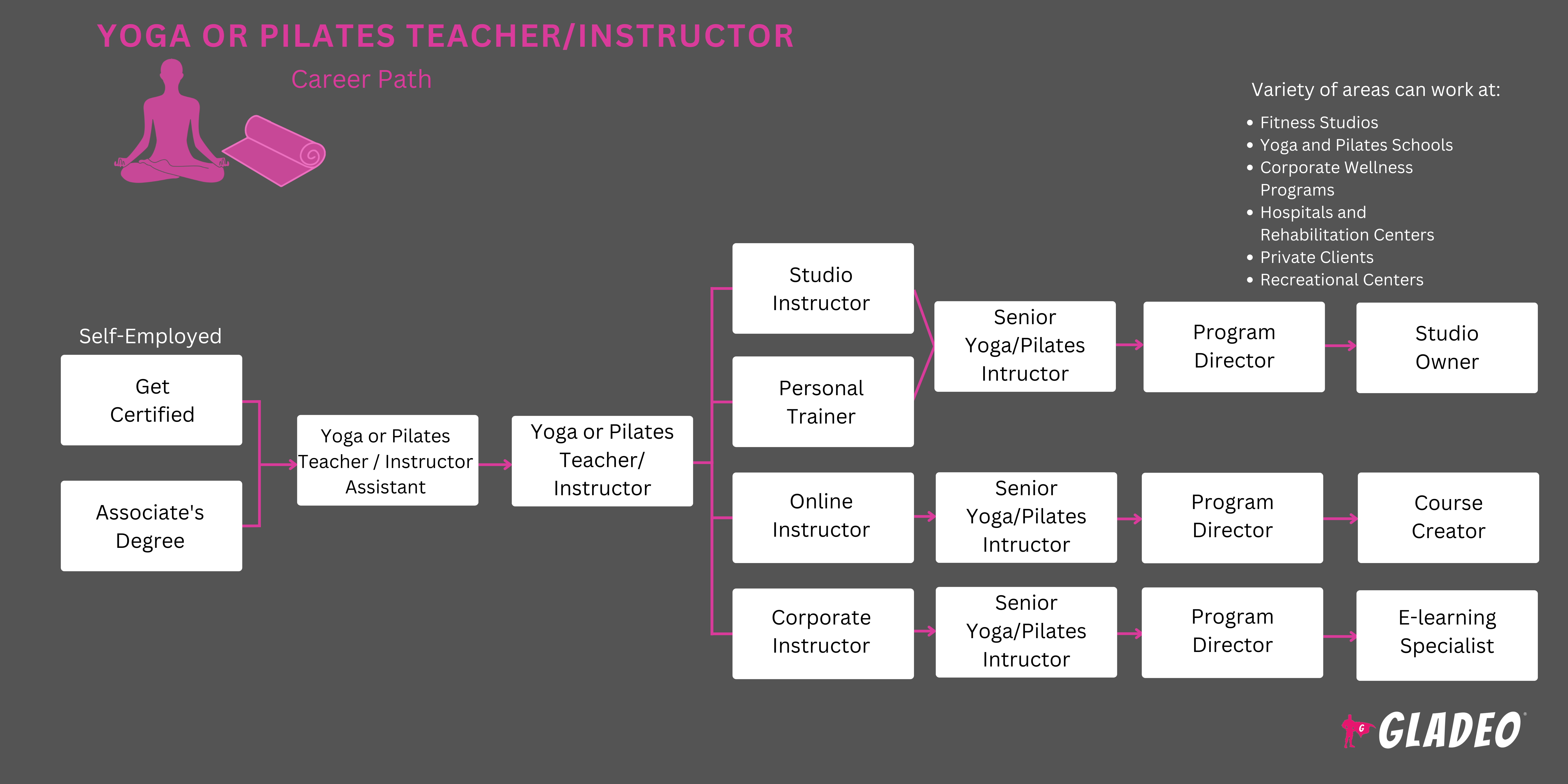Mga spotlight
Yoga Coach, Pilates Coach, Yoga Practitioner, Pilates Practitioner, Yoga Educator, Pilates Educator
The link between physical fitness and mental wellness has long been known, and the stress of modern life is driving more participation in healthier lifestyle choices. Two particular fitness activities have exploded in popularity in recent decades—yoga and pilates!
While there are similarities between the two, yoga involves holding stationary positions while focusing on breathing and meditation. Pilates incorporates small motions and is designed more for building strength and flexibility. Both practices are complex and students should ideally seek training from a professional Yoga or Pilates Teacher/Instructor.
Many instructors work ad hoc, teaching classes at local gyms or through community colleges. Some have studios or centers where they can host group or private one-on-one sessions. The job can be highly rewarding for those ready to master their yoga or Pilates skills and pass them on to others!
- Helping others enhance their strength, flexibility, and mental, physical, and spiritual health
- Keeping physically fit while teaching classes
- Being your boss and having flexibility with your schedule
Oras ng trabaho
- Yoga and Pilates Instructors have hectic schedules that often involve working late nights, weekends, and holidays. Larger theaters usually offer full-time jobs, whereas smaller venues may only need a part-time manager, depending on how frequently events are hosted.
Mga Karaniwang Tungkulin
- Reach out to potential client venues such as fitness centers
- Teach regularly scheduled yoga or Pilates classes
- Set up the classroom area, to include mats, music playlists, lighting, or other ambiance
- Take student attendance, if needed
- Demonstrate proper technique and breathing
- Conduct warm-up exercises before beginning the main activities
- Lead fitness sessions and monitor students for correct postures
- Offer corrective feedback and provide encouragement and motivation
- Pay attention to signs that a student may be struggling or feeling unwell
- Meet with students to discuss individual needs. Review their fitness goals and progress
- Perform general business duties, such as billing and accounting (unless the employer or venue client manages those)
- Offer one-on-one recommendations such as different styles of yoga or activities to try
- Collaborate with venues as needed to ensure classes are scheduled for optimal times to encourage maximum participation
- Advertise classes and services via social media and other methods
Mga Karagdagang Pananagutan
- Manage a calendar of upcoming classes or appointments
- Advertise classes and services via social media, flyers, local events websites, etc.
- Manage business-related budgets and ensure all needed supplies are on hand
- Procure liability insurance and establish policies to protect against legal issues if a student injures themselves
- Ensure exits are marked and unobstructed
- Stay aware of industry changes and trends
- Review special student needs or requests
- Gain participant consent if taking photos or videos
- Be prepared to render first aid or CPR
Soft Skills
- Serbisyo sa customer
- Empatiya
- Sigasig
- Kakayahang umangkop
- Nakatuon sa layunin
- Inisyatiba
- Nakikinig
- Mga kasanayan sa pagganyak
- mapagmasid
- Organisado
- pasyente
- Nagpupursige
- Pagtugon sa suliranin
- Punctual
- Nakatuon sa kaligtasan
- Malakas na kasanayan sa komunikasyon
- Kasanayan sa pagtuturo
- Pamamahala ng oras
Teknikal na kasanayan
- Familiarity with basic accounting and self-employment taxes, if applicable
- Familiarity with social media marketing and other advertising
- Pangunang lunas at CPR
- Knowledge of yoga forms or Pilates
- Knowledge of suitable teaching practices
- Fitness and recreational centers
- Practice practice studios
Yoga and Pilates Instructors may not always have full-time positions or even work for a single employer. Some teach ad hoc classes at local gyms or community colleges, sharing profits with the host facility. Others set up their own private studios or centers, usually by renting a downtown office or space within an office building. Some teach from home studios or visit clients at their residences.
Because instructors are frequently self-employed, they must know the basics of running a small business, including securing a place to operate, billing clients, managing safety matters, paying taxes, and advertising their services and classes. Many instructors work when most clients will be available to attend, which is early morning, after typical 8-5 work hours, or on weekends.
Though it is thousands of years younger than yoga, the Pilates movement has taken the West by storm, with numerous celebrity enthusiasts driving interest higher than ever. Social media in particular is generating a ton of awareness for this once-obscure activity that can help practitioners burn fat and get toned.
Still, the rise of the yoga industry is hardly slowing down, with some 36 million practitioners in the US alone and a whopping $9.09 billion generated in annual revenue. Signs point to a nearly 10% compound annual growth rate (while fitness trainers generally are projected to enjoy a 19% job outlook growth through 2031). Scientific research on the benefits of yoga continues to highlight the value of this therapeutic activity, which may boost its popularity even more in the coming years!
Yoga and Pilates Instructors are typically enthusiasts who’ve been practicing for many years and decided to start teaching others. This may have begun informally, by showing a friend or family member the benefits of engaging in the activity. Instructors are often outgoing and motivated to lead group or private sessions that will benefit their students’ health and well-being. They feel comfortable holding a teaching role, which may have come from helping to raise younger siblings or from involvement in school activities.
- Yoga and Pilates Instructors don’t need any formal education but many choose to get certified by an accrediting body
- O*Net notes that 57% of workers in these fields have a post-secondary certificate, while 10% have an associate’s degree
- Self-employed instructors may be less likely to pursue a formal certification route. Those who want to get hired by an employer may opt for certification to increase their odds
- There are many popular styles of yoga, such as Hatha, Yin, Vinyasa, Bikram (hot yoga), Iyengar, Ashtanga, Kundalini, and Power yoga. Employers may prefer that candidates specialize in a particular type
- Yoga Alliance allows training centers to apply to become a Registered Yoga School (RYS). Students who graduate from an RYS can apply for an RYS Certificate
- Alternatives to Yoga Alliance include:
- Association of Yoga Professionals
- Black Yoga Teachers Alliance
- Christian Yoga Association
- International Association of Yoga Therapists
- National Association of Certified Yoga Teachers (NACYT)
- World Yoga Federation
- Yoga Teacher Central
- Yoga Unify
- In addition to a certification, employers may wish to see a minimum number of logged experience hours, plus proof of first aid/CPR certification
- Pilates instructors may enroll in a training program featuring courses such as Pilates history, basic principles and applications, mat exercises, and Pilates for injuries and disorders
- Some students customize their own training and take classes over a period of months from different instructors
- The National Pilates Certification Program offers a Nationally Certified Pilates Teacher certificate
- Additional certs include:
- Yoga and Pilates Instructors don’t need a college degree, but there are several certifications offered by various organizations that can boost your credentials!
- When reviewing certification options, consider the program’s reputation, value, and areas of focus offered.
- As soon as possible, decide what you want to teach—yoga (and which type of yoga) or Pilates
- Watch YouTube channels like Yoga with Adriene or Move with Nicole. Study their techniques, including their speaking styles and cadences
- Read books, magazines, and website articles about the area you intend to teach. Learn as much as you can!
- In addition to taking yoga or Pilates classes, other physical fitness classes or personal exercise activities are helpful to get in peak condition. You’ve got to be ready to teach many classes in one day!
- Study hard in high school courses such as biology, health, and speech
- Sign up for extracurricular activities where you can get in front of groups and lead activities
- Ask your yoga and Pilates teachers for advice about how they got started and what their education and training paths were like
- See if you can volunteer as an assistant or substitute for them for a few classes
- Host free classes with friends, schoolmates, or co-workers where you can get experience
- Offer donation-based classes or trade free lessons in exchange for something students can offer (for example, cooking lessons)
- Keep track of the number of participants and the number of hours you instruct. If you earn any income, keep track of that, too!
- Learn about first aid and emergency preparedness

- Yoga and Pilates Teachers have a few routes to finding work. They can:
- Apply for full- or part-time jobs
- Apply to teach classes within someone else’s venue
- Set up shop for themselves by renting a space
- Hold private classes within a client’s own residence
- If you apply for jobs, employers may want to see proof of some third-party certification, such as from Yoga Alliance or the National Pilates Certification Program
- Check out popular job sites like Indeed, ZipRecruiter, and LinkedIn
- Read the application requirements and apply to the positions you’re most qualified for
- If you discover you’re not meeting the qualifications for many jobs, take note of what you’re missing and get that done!
- Check out Yoga and Pilates Instructor resume templates and sample interview questions
- Venues that host instructors may be more flexible about requiring certification, but certification will likely open more doors because it helps validate your skills
- Reach out to local venues such as community centers, fitness centers and gyms, youth centers, eldercare facilities, chiropractic offices, community colleges, and local businesses that offer wellness classes to employees. Inquire about opportunities to hold classes at their sites
- If you don’t have a certification, show them proof of any classes you’ve led, including the number of participants, the number of total hours you’ve instructed, revenue earned, student reviews, etc.
- Offering a free session is a popular way to generate interest in a class
- Make sure to do your own advertising, versus simply relying on the venue’s
- Those who run their own business are less likely to need a certification but will still need to demonstrate their abilities
- One way that entrepreneurial teachers can show off their skills is by creating videos to post on your own website or by creating a YouTube channel, or profiles on Instagram and TikTok
- Create a Google Business profile and consider registering as an LLC
- Ask your college instructors or fellow students about teaching openings they’re aware
- Contact clients/students you’ve had that would be willing to be a personal reference
- The way to move up in a career as a Yoga or Pilates Instructor varies because there are different employment options
- Those who work for an employer may qualify for a raise by garnering many positive reviews from students and bringing in plenty of revenue
- They might also qualify by taking specialized training or getting advanced certifications so they can expand their service offerings and potentially charge more money
- Those who conduct classes at various venues may want to apply for a full-time job. They can demonstrate their potential by showing the statistics about the number of classes they’ve led and the students they’ve taught
- Those who are self-employed may be able to move up by hiring additional teachers and moving into more of a managerial role
- They might also take specialized training or get advanced certifications so they can expand their service offerings and charge clients more
- Some instructors make a conscious effort to cater to a high-end clientele that can afford to pay top dollar (for example, celebrity instructor Amanda Kassar, who sells her own apparel and merchandise, as well)
- Many instructors capitalize on monetized social media to earn or supplement their income
- No matter what the employment type, Yoga and Pilates Instructors must stay on top of their game and never stop learning
- Constant advertising of classes is key to raising awareness and generating interest—and income!
- Many instructors pay for liability insurance, which doesn’t necessarily boost your earnings but it does mitigate your risk of financial losses in the event of a lawsuit. A penny saved is a penny earned!
- Participate in professional organizations and grow your reputation as a Yoga and Pilates Instructor who is competent, enthusiastic, and motivating!
Mga website
- AAAI/ISMA Fitness (American Aerobic Association International and International Sports Medicine Association)
- American College of Sports Medicine
- American Council on Exercise
- American Sports and Fitness Association
- Athletics and Fitness Association of America
- Asosasyon ng Kalusugan at Kalusugan ng IDEA
- International Health, Racquet & Sports Club Association
- National Academy of Sports Medicine
- National Commission for Certifying Agencies
- National Council on Strength and Fitness
- National Federation of Professional Trainers
- National Pilates Certification Program
- National Strength and Conditioning Association
- US Registry of Exercise Professionals
- Yoga Alliance
Mga libro
- Anatomy of Yoga: An Instructor’s Inside Guide to Improving Your Poses, by Dr. Abigail Ellsworth
- Ellie Herman's Pilates Arc & Barrels: A Manual for Pilates Instructors & Serious Pilates Students, by Ellie Herman
- Pilates Anatomy, by Rael Isacowitz and Karen Clippinger
- Teaching Yoga: Essential Foundations and Techniques, by Mark Stephens and Mariel Hemingway
- The Professional Yoga Teacher’s Handbook: The Ultimate Guide for Current and Aspiring Instructors, by Sage Rountree
It’s not always easy to launch a successful career as a Yoga or Pilates Instructor, especially if you don’t live in an area where there is much interest in such activities. For those who want to explore a few similar career fields, check out our below list!
- Coach and Scout
- Physiologist ng ehersisyo
- Fitness and Wellness Coordinator
- Physical Therapist
- Katulong ng Physical Therapist
- Recreational Therapist
- Manggagawa sa Libangan
- Self-Enrichment Teacher
Newsfeed

Mga Tampok na Trabaho

Mga Online na Kurso at Tool

Mga Inaasahan sa Taunang Sahod
New workers start around $36K. Median pay is $51K per year. Highly experienced workers can earn around $64K.






